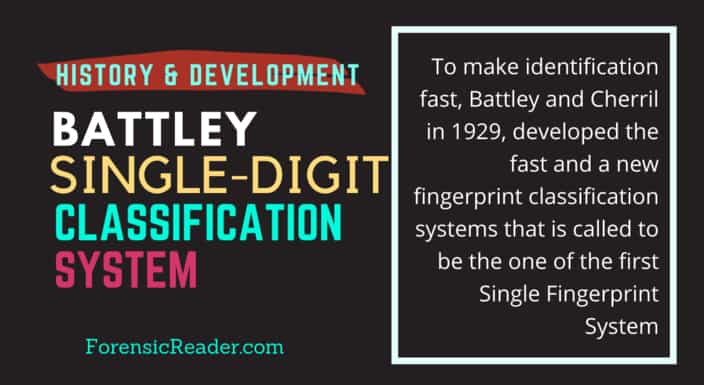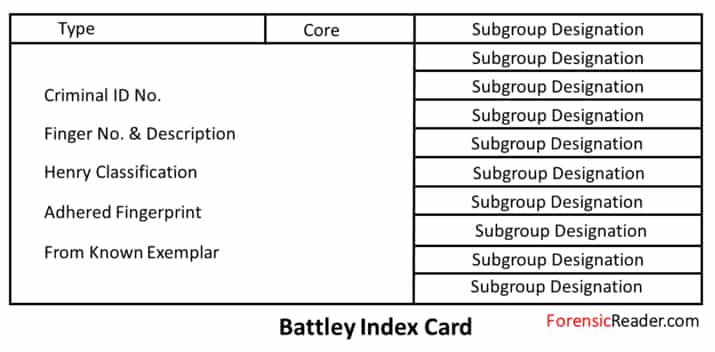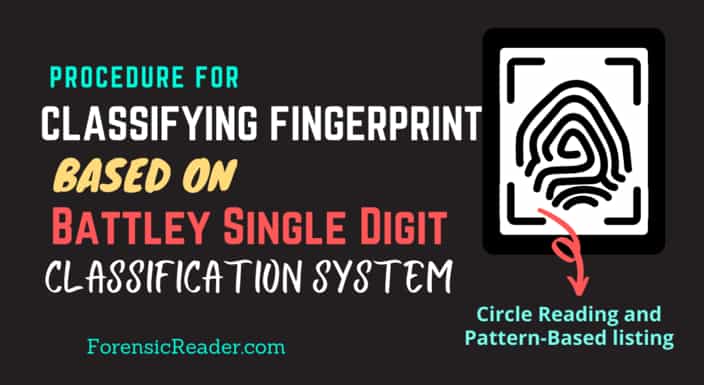Battley classification is a single-digit classification system that was designed to make fingerprint identification easy and less time-consuming.
But there is more to it.
Let’s dig deeper and know more about the Battley single-digit classification system in detail.
What is the Battley Single-Digit Classification System?
Chief Inspector Harry Battley and Detective Superintendent Fredrick Cherrill of New Scotland Yard were known to be the true gems that led the foundation of the single-digit classification system.
There are a lot of other single-digit classification systems but the Battley classification system was one of the most popular and oldest systems that were developed in 1929.
Need of Battley Single Digit System
Single-digit fingerprint classification systems emerge from the necessity of latent prints that were found on the crime scene.
As at the crime scene, most of the prints are not 10-digit, hence apprehension of criminals based on that, was quite difficult and time-consuming.
This leads to the emergence of a single-digit fingerprint classification system, which is also the fact behind the development of the Battley classification and identification system.
History and Development of Battley Single Digit System

With the idea of making identification fast, Battley and Cherril in 1929, developed one of the most sophisticated, fastest, and new fingerprint classification systems that are called the Single Fingerprint System.
As stated earlier, the need for the single-digit classification system was to provide rapid identification using fingerprints that were left on the crime scene.
Conversely, with time, as it has a single-digit system, there were a lot of fingerprints per person—10x more than the Henry classification system.
This all required a great amount of work in maintaining and classifying it.
Eventually, the fingerprint data became so large that it became impossible to accurately and quickly individualize specific prints.
Collection of Fingerprints for Battley Single-Digit Classification
Battley single-fingerprint system has a special card on which each print will register.
This special type of battery fingerprint registered card is called the Battley index card.
The following is how a Battley index card looks like.

In a Battley index card, the following information is registered:
- Number of digits
- Name of digits
- Criminal reference number
- Henry Classification (if done)
- Adhered Fingerprint
- 10-subgroup designation
So, for each fingerprint, a Battley index card is filled. For each person, there is 10 index card from the right thumb (#1 collection) to the left little finger (#10 collection).
Also Read:
- Henry Fingerprint Classification System: Key Major, Primary, Secondary and Subsecondary
- Vacuum Metal Deposition: Principle, Types & Components
- Loop Fingerprint Pattern: 5 Rules and 4 Types With Images
Procedure for Classifying Fingerprint Based on Battley Single Digit Classification System

The following is the step-by-step guide on how the Battley index card is registered for the specific fingerprint.
1. Collection of Prints
In the Battley system of single-digit classification, all fingerprints of an individual should be taken as rolled fingerprints in the individual drawer of the fingerprint chart.
2. Subdivision Sets in Battley Classification
In this single digit fingerprint system, the print was first classified based on two broad sets. These are:
- Pattern-Based Subdivision
- Radial or ulnar inclination
- Ridge counts and tracing (using Battley reticle)
- Formation of the core(s)
- Position of the delta(s)
- Circle Reading Subdivision
Pattern-Based Subdivision
There is a misconception that the Battley single fingerprint classification system only uses the circle reading classification method.
Nevertheless, it’s not true.
The Battley single fingerprint system uses ten major pattern types that are further subdivided on their specific characteristics.
The following table illustrates all the subdivisions along with the designation that you needed in order to classify fingerprints.
| Pattern | Subdivisions | Designation |
|---|---|---|
| Arches | Plain Arch | 1 |
| Left-sloping | 2 | |
| Right-sloping | 3 | |
| Tented Arches | Circle reading (summit of first platform ridge) | A-H |
| Radial loops | Ridge count between delta and core | # |
| Predetermined core definitions | A-L | |
| Circle reading of delta | A-H | |
| Ulnar loops | Ridge count between delta and core | # |
| Predetermined core definitions | A-L | |
| Circle reading of delta | A-H | |
| Whorls/Central pocket loops | Circle reading of first recurving ridge | A-H |
| Predetermined core definitions limited to small spirals in “A” circle reading | A.1A.2A.3A.4 | |
| Circle reading of left delta | A-H | |
| Ridge tracing | I,M,O | |
| Circle reading of right delta | A-H | |
| Ridge count between left delta and core | # | |
| Ridge count between right delta and core | # | |
| Twinned Loops | Radial or ulnar slope of descending loop | R,U |
| Circle reading of core of descending loop | A-H | |
| Ridge count between loops | # | |
| Ridge count between core and delta of descending loops | # | |
| Circle reading of left delta | A-H | |
| Ridge tracing | I,M,O | |
| Circle reading of right delta | A-H | |
| Lateral pocket loops | Radial or ulnar slope of majority of ridges | R,U |
| Ridge count between delta and core of innermost loop | # | |
| Composite | No division | |
| Accidental | No division | |
| Severely scarred | Cannot classify |
Circle Reading Subdivision
In this subdivision, a special magnifying glass—reticle based magnifying glass—is used for the analysis.
Battley reticle magnifying glass has;
- a center circle along with an apex dot in the middle (called point A), and
- 7 concentric circles, each 2 mm in width.
These 7 concentric circles have respective radii of 3mm, 5mm, 7mm, 9mm, 11mm, 13mm, and 15mm. Each radius is represented by an alphabet from ‘B’ through ‘H’.

After that, instead of counting ridges, the distance between the delta and cores is determined by placing the central apex dot on the innermost recurving ridge.
More precisely, this single-digit classification system uses a special core.
In loops and whorls, the special core is located in the center of the pattern to obtain circle readings.
After that, a corresponding alphabetical designation is given based on the ring to which the delta appears. Or you can say, the circle which touches or crosses the delta.
Also Read:
- Vacuum Metal Deposition: Principle, Types & Components
- Doll’s Eye Reflex: Principle, Cause, Procedure
- How Fingerprints are Classified using NCIC Classification System?
- Magnetic Powders: Types, Principle, Fingerprint Development, Advantages And Disadvantages
Other Single Digit Fingerprint Classification System
| Name of single print system | Subdivisions |
| Collins | Pattern types, Ridge counts, Ridge tracing, and Ridge characteristics |
| Larson | Pattern types, Inclination of Pattern, Core type, Ridge characteristics, Delta type, Ridge tracing and combinations |
| Oloriz | Primary from Oloriz tenprint system, Core type, Limiting Lines (Type Lines), Delta types and Apex Angle |
| Borgerhoff | Pattern types, Ridge counts and Ridge tracing |
| Stockis | Pattern types, Ridge counts, Apex Angle, Core type, Delta type and Ridge tracing |
| Gasti | Taken from Gasti (tenprint) classification for each finger |
| Born | Pattern type, Zone scheme with marked minutiae |
| Sagredo | Primary from Oloriz Tenprint System, No delta pattern type, One delta pattern type, Two delta pattern type, Pattern inclination, Ridge counts, Ridge tracing and Delta type |
| Dresden | Pattern types, Ridge counts and Pattern inclination |
| Neben Register of Roscher | Taken from Roscher tenprint classification for each finger |
| Lyonnese | Pattern type, Central basal angle from Oloritz and Ridge tracing |
| Barlow | Pattern type, Pattern inclination, Core type and Ridge counts |
| Jaycox | Pattern type, Pattern inclination, Core type and Ridge characteristics of core |
| Jorgenson | Pattern type, Pattern inclination, Ridge counts, Core type, Delta position, Core to delta angle, Core diameter (whorl) |
| Crosskey | Pattern type, Core type, Ridge counts and Presence of scar |
References
- Battley, H., Single Finger Prints, Yale University Press, New Haven [Onelibrary.Wiley]
- Fingerprint Analysis Laboratory Workbook by Hillary Moses Daluz [Book]
- The Fingerprint: Source Book by NIJ.Gov
- Friction Ridge Skin: Comparison and Identification of Fingerprints by James M. Cowger [Book]

This article is made possible because of the efforts of Anuwanshi Sharma. She writes a part of this blog post. You can know more about her form here.

FR Author Group at ForensicReader is a team of Forensic experts and scholars having B.Sc, M.Sc, or Doctorate( Ph.D.) degrees in Forensic Science. We published on topics on fingerprints, questioned documents, forensic medicine, toxicology, physical evidence, and related case studies. Know More.
